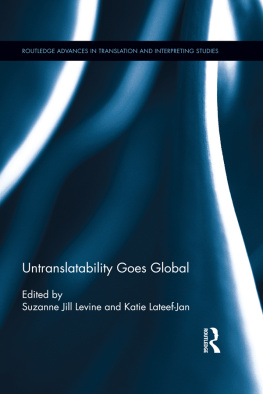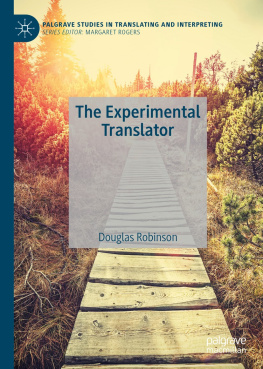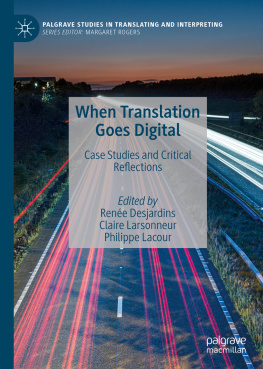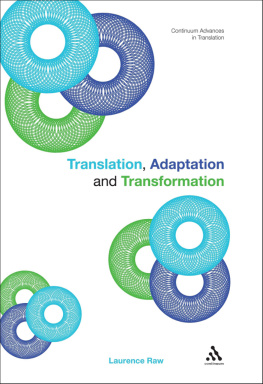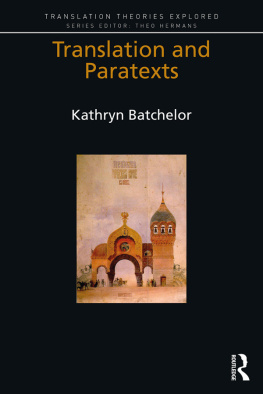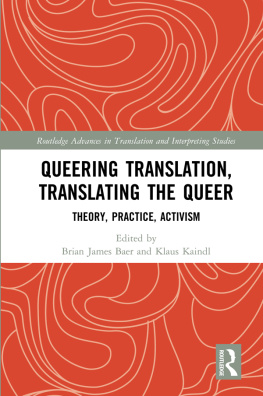The right of the editors to be identified as the authors of the editorial material, and of the authors for their individual chapters, has been asserted in accordance with sections 77 and 78 of the Copyright, Designs and Patents Act 1988.
All rights reserved. No part of this book may be reprinted or reproduced or utilised in any form or by any electronic, mechanical, or other means, now known or hereafter invented, including photocopying and recording, or in any information storage or retrieval system, without permission in writing from the publishers.
Trademark notice: Product or corporate names may be trademarks or registered trademarks, and are used only for identification and explanation without intent to infringe.
Routledge Advances in Translation and Interpreting Studies
For a full list of titles in this series, please visit www.routledge.com
19 Critical Translation Studies
Douglas Robinson
20 Feminist Translation Studies
Local and Transnational Perspectives
Edited by Olga Castro and Emek Ergun
21 Studying Scientific Metaphor in Translation
An Inquiry into Cross-Lingual Translation Practices
Mark Shuttleworth
22 Translating Frantz Fanon Across Continents and Languages
Edited by Kathryn Batchelor and Sue-Ann Harding
23 Translation and Public Policy
Interdisciplinary Perspectives and Case Studies
Edited by Gabriel Gonzlez Nez and Reine Meylaerts
24 Translationality
Essays in the Translational-Medical Humanities
Douglas Robinson
25 The Changing Role of the Interpreter
Contextualising Norms, Ethics and Quality Standards
Edited by Marta Biagini, Michael S. Boyd and Claudia Monacelli
26 Translation in Russian Contexts
Culture, Politics, Identity
Edited by Brian James Baer and Susanna Witt
27 Untranslatability Goes Global
Edited by Suzanne Jill Levine and Katie Lateef-Jan
Contents
SUZANNE JILL LEVINE
ALFRED MAC ADAM
VAL VINOKUR AND ROSE RJOUIS
RAINIER GRUTMAN
ODILE CISNEROS
DOMINIQUE JULLIEN
GUY BENNETT
BATRICE MOUSLI
VIOLA MIGLIO
NICOLE CT
GAUTI KRISTMANNSSON
Guide
7
what happens letting words dance from one language to another
Guy Bennett
In the mid-1960s Italian poet Giovanna Sandri (19232002) began using dry-transfer lettering to create abstract graphic compositions that would come to be featured in exhibitions of visual and concrete poetry internationally, as well as in the Quadriennale di Roma (1968) and the Biennali di Bolzano (1969), di Venezia (1978), and de So Paulo (1981). Her unique visual texts, which would soon share the page with verbal texts, were also the subject of two solo exhibitions: alfabeto/albero del Tempo [alphabet/ tree of Time] at the Galleria Civica dArte Modena, Palazzo Te, Mantua (1977), and errtern (occhi/tarocchi per estrarre segni) [errtern (eyes/ tarots for extracting signs] in the Libreria Internazionale oolp, Turin (1978). Though she also wrote purely verbal poems, her entire body of work is characterized by an exploration of the graphic qualities of written signs and a preoccupation with the formal composition of the poetic text, traits that present interesting challenges for the translator.
Sandris books range from volumes of strictly visual poetry, to strictly verbal poetry, to a hybrid of the two. In all cases, the poetic text is like a drawing or painting in that its unique shape and position on the page are integral parts of its overall composition. Furthermore, in certain of her books the basic poetic unit is not the single page but the two-page spread, and in such cases the notion of the poem expands to include the binary of texts appearing on facing verso and recto pages. It goes without saying that all of these elements, in addition to semantic content of course, must be taken into account in the translation of her work.
I began translating Sandri in 1995, when Paul Vangelisti asked me for an English version of her poem origine lunare dellalfabeto (1978) for a journal he was editing at the time.
In the remarks that follow, I would like to focus on the translation of one book in particular clessidra: il ritmo delle tracce and share excerpts from an exchange I had with the author during the translation process.
Recipient of the 1992 Premio Lorenzo Montano, clessidra is a beautiful if slim volume of hybrid, verbo-visual poems of the kind mentioned above, the visual texts all being repurposed from her first book, Capitolo Zero [Chapter Zero]. Luigi Ballerini, a close friend of Sandris, brought me a copy of clessidra , a gift from the author, in November 1996. The work immediately appealed to me and I soon began to translate it. By this time I was corresponding with Sandri and was thus able to ask her about the poems and, since she knew English, send her my versions to look over. She received a complete draft of the translation in February 1997 and wrote back in May, sending me her suggestions and annotations either handwritten on the proofs themselves in the case of minor corrections or changes, or typewritten on a half-sheet of paper and stapled to the proofs in the case of lengthier commentary. In the letter that accompanied them, she wrote:
here are your beautiful translations sliding throughout the white pages as I expected: even in English they keep the flowing rhythm you succeeded in perceiving, not to speak about your visualization
(and rhythm in its Greek etymology is linked to the verb to flow )
if I compare your translations with mine, I see yours have a more abstract, impersonal flavor
(see encounter , far better than meeting : I translated in the words/she meets/but fragments/she finds , while you, in the words/encountered/only frag/ments found , far, far better, bravo)
[]
youll find my suggestions/corrections in the notes I have written for some poems, when my interpretation is different, and please let me know if you agree with them as my English may create some problems. I also added some personal references as, even if I havent yet met you personally, I like to dialogue with you through these notes
In those translations that Sandri annotated, she felt that I had either misunderstood a word or passage or considered that it could have been rendered more effectively. In the alternate renderings she proposed she occasionally allowed herself changes that, as a translator, I wouldnt have considered, or perhaps even thought of, had she not brought them up. The first such poem I will give here is creazione illimitata [limitless creation], reproduced on page 79. On top in Sandris typewritten notes stapled to the page proof of my translation (they cover the visual part of the poem on the facing page).

Two-page spread of Giovanna Sandris creazione illimitata

